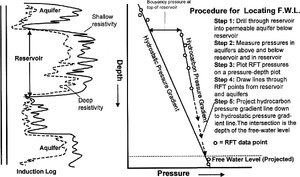Free water level determination using pressure
The free-water level occurs where buoyancy pressure is zero in the reservoir-aquifer system. It defines the downdip limits of an accumulation. Pressure data reliability affects the resolution; however, resolution improves when it is supplemented with other petrophysical information.
Procedure: using RFT data[edit]
An easy method for determining free-water level (FWL) is projecting RFT pressure data downward from a reservoir to the aquifer. The figure below illustrates the procedure.
Procedure using a single measurement[edit]
The table below outlines the procedure for determining the free-water level using a single pressure buildup point in the reservoir.
| Step | Action |
|---|---|
| 1 | Determine buoyancy pressure (Pb ) at the depth of the measured pressure (Pm ) from the measured pressure:
|
| 2 | Determine buoyancy pressure gradient (Pbg ):
|
| 3 | Calculate downdip length of hydrocarbon column (h):
|
As an example, let's determine the downdip length of a 30°API oil column with the following givens:
- Pm = 3555 psi at 7611 ft
- Phydrostatic = 3525 psi
- Phydrostatic pressure gradient = 0.465 psi/ft
- Phydrocarbon pressure gradient = 0.38 psi/ft
Answer (tied back to steps above):
Step 1:
Step 2:
Step 3:
- Failed to parse (syntax error): {\displaystyle \mbox{h} = \frac{\mbox{P}_{\rm b}}{\mbox{P}_{\rm bg}} = \mbox{30 \mbox{ psi}}{0.054 \mbox{ psi/ft}} = 556 \mbox{ ft}}
Therefore, the free-water level is at depth::8167 ft.
See also[edit]
- Static hydrocarbon pressure gradients
- Estimating static oil pressure gradients
- Estimating static gas pressure gradients
- Plotting the hydrocarbon pressure gradient





